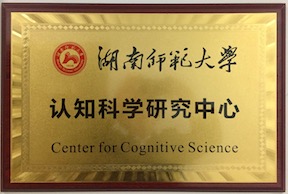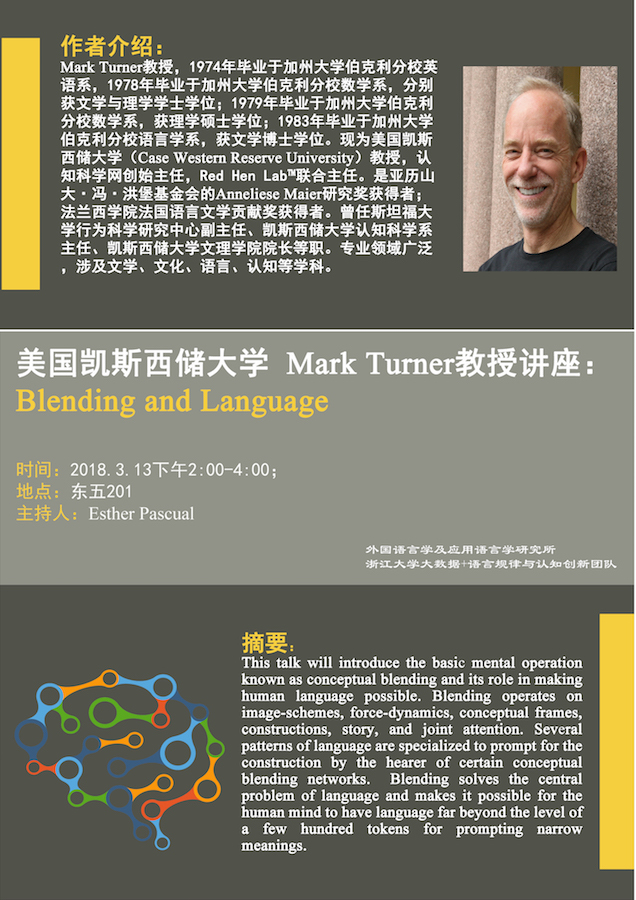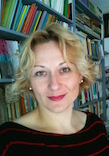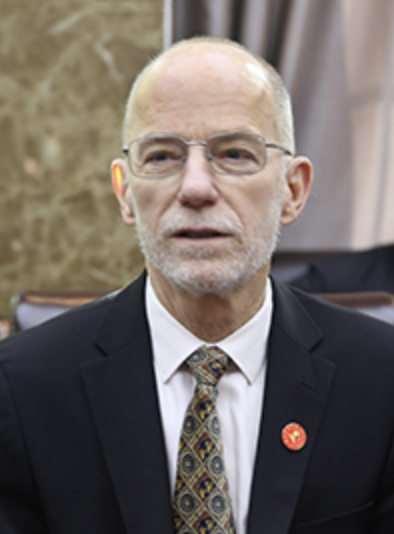



|
| Talks, Conferences, Colloquia, and Seminars at the Center for Cognitive Science |
|
|
|
|
View the website for the 2022 International Conference on Multimodal Communication, including recordings of all the plenary lectures. The conference was held 16 & 17 December 2022. |
|
|
|
|
|
View the website for the 2021 International Conference on Multimodal Communication, including recordings of all the plenary lectures. The conference was held 11 & 12 December 2021. |
|
|
View the website of the 2020 International Conference on Intercultural Multimodal Communication, including recordings of all the plenary lectures. The conference was held 12-13 December 2020. |
|
| |
|
|
|
|
|
Imagining Our Futures: Mark Turner
A Free Public Lecture Series
Standard Venue: Room 613,
Foreign Studies College, Hunan Normal University.
Exception: 9am, 6 January, Room 113, Zhonghe Building.
Schedule:
Preliminary Reading: "Rethinking Metaphor"
Mark Turner is Institute Professor and Professor of Cognitive Science at Case Western Reserve University and Distinguished Visiting Professor at Hunan Normal University.
Abstract:
To imagine futures that differ qualitatively and importantly from our pasts is an astonishingly creative human mental feat: we can have no experience of those futures whatsoever and must build them out of present conceptions, knowledge, memories, and experiences, using amazing mental operations of invention, inference, and evaluation. It seems to us relatively straightforward and uncomplicated to imagine futures; they simply “come to mind.” How could we not imagine them? But, in fact, nearly all the cognitive work performed to conceive these futures occurs in backstage cognition in ways much too complicated for consciousness to hold or view, and although other species have instincts with long-range consequences—lust leads to great-grand-offspring; hunger leads to bodily growth and nutrition—none of those species has anything remotely like the everyday indispensable human power to imagine and weigh futures. When we think about these futures, we think about people, actions, and landscapes that stretch across vast ranges of time, space, causation, and agency. What will happen to the Chinese Yuan Renminbi? To the US Dollar? Geopolitics in Southeast Asia? Our grandchildren? Higher education? Artificial Intelligence? Automation? Population? The Global South? Air travel? Space travel? Automobile travel? Health care? Climate? Our own mobility? What will I build? What legacy will I leave? What guilt will I bear? Is there a chance? What are the odds? What’s my future? What’s your future? What’s their future? What’s our future? This talk will review the cognitive toolbox of operations involved in imagining our futures and forms of discourse and language for communicating about them.
|

|
|
|
|
|
Seminar on Media Analysis: Mark Turner
Mark Turner is Institute Professor and Professor of Cognitive Science at Case Western Reserve University and Distinguished Visiting Professor at Hunan Normal University. |
|
|
|
|
|
Research Methods in Multimodal Communication
A Free Public Lecture Series
Venue:
On 5-6 January, Room 230, College of Chemistry and Chemical Engineering.
湖南师范大学外国语学院 第二届“外国语言与文化”讲习班通知
Schedule:
Mark Turner is Institute Professor and Professor of Cognitive Science at Case Western Reserve University and Distinguished Visiting Professor at Hunan Normal University. | |
|
|
|
|
Seminar on Cognitive Analysis of Prose Style: Mark Turner
Foreign Studies College, Hunan Normal University, Room 404 Background reading for the seminar: Thomas, Francis-Noël and Mark Turner. 2011. Clear and Simple as the Truth: Writing Classic Prose. Second Edition. Princeton University Press.
Schedule:
Mark Turner is Institute Professor and Professor of Cognitive Science at Case Western Reserve University and Distinguished Visiting Professor at Hunan Normal University. | |
|
|
|
|
| |
 | |
The Big Data Turn in Linguistics. Summary of the talk | |
|
| |
|
Colloquium: Renata Geld Renata Geld is assistant professor and Head of SLA and TEFL Section, Department of English, Faculty of Humanities and Social Sciences, University of Zagreb. |  |
| Abstract: There have been a number of movements and a considerable body of work employing insights from linguistics in describing and analyzing other modes of representation. In the past, the work in question was mostly concerned with lexis, but more recently the attention has been moved to grammar (Kress and Leeuwen 2006). Drawing on this important theoretical and applied shift in thought, we made a step further and, for our own purpose of analyzing L2 strategic thinking and strategic representation, looked at the extent to which visual and textual construal of meaning corresponds to cognitive linguistic description of language. The examples selected to be presented in this talk are visual in nature and they were taken from our multimodal L2 speaker/learner corpora consisting of over 4000 textual and visual answers obtained from speakers of English with different L1 (Arabic, Croatian, Czech, and Spanish). Their answers were solutions to the challenging task of representing semantic contribution of topological and lexical components constituting English particle verbs (PVs). The task was quite straightforward: the participants were provided with a list of PVs and each verb was accompanied with one of its figurative meanings, for example – pull in ‘attract people in large numbers’ or write down ‘reduce the value of what a company owns’. Our analysis resulted in four distinct categories of what the participants represented in their drawings: a) literal compositionality (drawings include literal meaning of both PV components); b) visual paraphrase (drawings represent the figurative meaning given in the task without individual attention to the contribution of the components); c) partial conceptual integration (drawings represent the figurative meaning given plus the meaning of either topological or lexical component); and d) full conceptual integration (drawings represent the figurative meaning given plus the meaning of both components). We shall discuss elements affecting the frequency of the above-mentioned categories as well as overall tendencies in representing the two components constituting PV constructions. Reference: Kress, G. R. and Theo van Leeuwen. 2006. Reading Images: The Grammar of Visual Design. Second edition. London: Routledge. | |
| Colloquium: Peter Whitehouse Peter Whitehouse is, at CWRU, Professor of Neurology, founding member of the Cognitive Science Department, and current or former Professor of Psychiatry, Neuroscience, Psychology, Bioethics, Nursing, History, and Organizational Behavior. He is also Strategic Advisor in Innovation at the Baycrest Health Center; Professor of Medicine and Institute of Life Course and Aging at the University of Toronto; and President of Intergenerational Schools International. | 
|
| Abstract: Cognitive Science, particularly as imagined at Case Western Reserve University, is (or in my view aspires to be) a transdisciplinary field at the forefront of knowledge and value exploration and application at the beginning of a new epoch in the 13.7 billion year Big History of the emergence of life on the planet, the Anthropocene. Studies of cognition and emotion allow opportunities to participate in necessary civilization, if not species, survival enhancing activities. Looking more positively cognitive science can help transform culture and contribute to human flourishing in an time that demands dramatic shifts in our attitudes about and behaviors towards living creatures and the planet and our shared future. Two specific projects will be described. The first is an attempt to develop a transdisciplinary intergenerative academic and community course entitled Wising up: designing a course for the future. I will report on design charrettes and pedagogical approaches that include experiential learning in community and especially museums. The topics currently being considered for inclusion in this course include brain health, positive aging, intergenerational learning, community-based health, eco-literacy, and spirituality. Special attention will be paid to narrative and embodied metaphor, as in a Tree Doctor performance character. The second project is a Dittrick Medical History Center exhibit entitled Reimag(in)ing dementia: neuroreflections on changing consciousness. This exhibit will occur when the International Society for the History of Neurosciences will be in Cleveland in June 2018. I will give the Oliver Sacks lecture focusing on the past, present, and future of the cholinergic basal forebrain or previously labeled Substantia Innominata or Nucleus Basalis of Meynert. The intention is to explore the use of scientific and artistic imaging and how they influence human imagination throughout the history of the neurological and psychiatric conceptualization and investigation of dementia. | |
|
Lecture Series on Creativity: Mark Turner Mark Turner is Institute Professor and Professor of Cognitive Science at Case Western Reserve University and Distinguished Visiting Professor at Hunan Normal University. | 
|
| Abstract: The human contribution to the miracle of life around us is obvious: We hit upon new ideas, on the fly, all the time, and we have been performing this magic for, at the very least, 50,000 years. We did not make galaxies. We did not make life. We did not make viruses, the sun, DNA, or the chemical bond. But we do make new ideas—lots and lots of them. They arise constantly in human minds, and sometimes tumble out of our minds to influence other minds and change the world. We have creative insight and we recognize new possibilities. Our new ideas are not fixed instincts—like a beaver’s instinct for building a dam or a bat’s instinct for echolocating and ingesting an insect. We have such instincts, but our amazing ability to come up with new ideas goes immeasurably far beyond these fixed instincts. Our ability for new ideas is at the root of language, the arts, and culture. These lectures will explore how.
| |